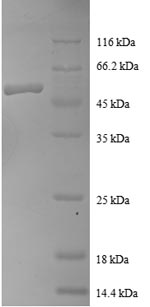The region for expressing recombinant Human RAB1A contains amino acids 2-205. The expected molecular weight for the RAB1A protein is calculated to be 49.5 kDa. This protein is generated in a e.coli-based system. The N-terminal GST tag was fused into the coding gene segment of RAB1A, making it easier to detect and purify the RAB1A recombinant protein in the later stages of expression and purification.
The human Ras-related protein Rab-1A (RAB1A) is a key regulator of intracellular vesicle trafficking. RAB1A functions within the Rab family of small GTPases. RAB1A plays a crucial role in the early secretory pathway, particularly in the transport of vesicles from the endoplasmic reticulum (ER) to the Golgi apparatus. Its main function involves the coordination of vesicle budding, transport, and fusion with target membranes. Additionally, RAB1A has implications for autophagy and cellular homeostasis. Research on RAB1A delves into its specific roles in vesicular transport, its regulatory mechanisms, and its involvement in various cellular processes, providing insights into potential therapeutic targets for diseases associated with membrane trafficking dysregulation.






